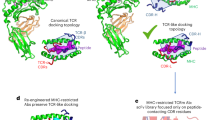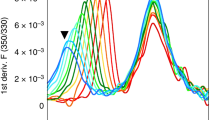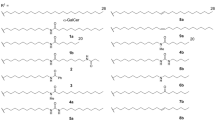Abstract
We have identified a heptapeptide with high affinity to rheumatoid arthritis–associated class II major histocompatibility (MHC) molecules. Using a model of its interaction with the class II binding site, a variety of mimetic substitutions were introduced into the peptide. Several unnatural amino acids and dipeptide mimetics were found to be appropriate substituents and could be combined into compounds with binding affinities comparable to that of the original peptide. Compounds were designed that were several hundred-fold to more than a thousand-fold more potent than the original peptide in inhibiting T-cell responses to processed protein antigens presented by the target MHC molecules. Peptidomimetic compounds of this type could find therapeutic use as MHC-selective antagonists of antigen presentation in the treatment of autoimmune diseases.
This is a preview of subscription content, access via your institution
Access options
Subscribe to this journal
Receive 12 print issues and online access
$209.00 per year
only $17.42 per issue
Buy this article
- Purchase on Springer Link
- Instant access to full article PDF
Prices may be subject to local taxes which are calculated during checkout


Similar content being viewed by others
References
Nepom, B.S. The role of the major histocompatibility complex in autoimmunity. Clin. Immunol. Immunopathol. 67, S50– S55 (1993).
Schiff, B., Mizrachi, Y., Orgad, S., Yaron, M. & Gazit, I. Association of HLA-Aw31 and HLA-DR1 with adult rheumatoid arthritis. Ann. Rheum. Dis. 41 , 403–404 (1982).
McMichael, S.J., Sasazuki, T., McDevitt, H.O. & Payne, R.O. Increased frequency of HLA-Cw3 and HLA-Dw4 in rheumatoid arthritis. Arthritis Rheum. 20, 1037–1042 (1977).
Ohta, N. et al. Association between HLA and Japanese patients with rheumatoid arthritis. Hum. Immunol. 5, 123–132 (1982).
Nepom, G.T. et al. HLA genes associated with rheumatoid arthritis: identification of susceptibility alleles using specific oligonucleotide probes. Arthritis Rheum. 32, 15–21 ( 1989).
Wordsworth, P. et al. HLA heterozygosity contributes to susceptibility to rheumatoid arthritis. Am. J. Hum. Genet. 51 585– 591 (1992).
Lanchbury, J.S. et al. Strong primary selection for the Dw4 subtype of DR4 accounts for the HLA-DQw7 association with Felty's syndrome. Hum. Immunol. 32, 56–64 (1991).
Gregersen, P.K., Silver, J. & Winchester, R.J. The shared epitope hypothesis. An approach to understanding the molecular genetics of susceptibility to rheumatoid arthritis. Arthritis Rheum. 30, 1205–1213 (1987).
Brown, J.H. et al. Three-dimensional structure of the human class II histocompatibility antigen HLA-DR1. Nature 364, 33– 39 (1993).
Stern, L.J. et al. Crystal structure of the human class II MHC protein HLA-DR1 complexed with an influenza virus peptide. Nature 368, 215–221 (1994).
Dessen, A., Lawrence, C.M., Cupo, S., Zaller, D.M. & Wiley, D.C. X-ray crystal structure of HLA-DR4 (DRA1*0101, DRB1*0401) complexed with a peptide from human collagen II. Immunity 7, 473–481 (1997).
Hammer, J. et al. Peptide binding specificity of HLA-DR4 molecules: correlation with rheumatoid arthritis association. J. Exp. Med. 181, 1847–1855 (1995).
Wucherpfennig, K.W. et al. Structural basis for major histocompatibility complex (MHC)-linked susceptibility to autoimmunity: charged residues of a single MHC binding pocket confer selective presentation of self-peptides in pemphigus vulgaris. Proc. Natl. Acad. Sci. USA 92, 11935– 11939 (1995).
Todd, J.A. et al. A molecular basis for MHC class II-associated autoimmunity. Science 240, 1003–1009 ( 1988).
Hammer, J., Takacs, B. & Sinigaglia, F. Identification of a motif for HLA-DR1 binding peptides using M13 display libraries. J. Exp. Med. 176, 1007–1013 (1992).
Hammer, J. et al. Promiscuous and allele-specific anchors in HLA-DR-binding peptides. Cell 74, 197–203 ( 1993).
Adorini, L. et al. In vivo competition between self peptides and foreign antigens in T cell activation. Nature 334, 623– 625 (1988).
Sakai, K. et al. Prevention of experimental encephalomyelitis with peptides that block the interaction of T cells with major histocompatibility complex proteins. Proc. Natl. Acad. Sci. USA 86, 9470– 9474 (1989).
Hurtenbach, U., Lier, E., Adorini, L. & Nagy, Z.A. Prevention of autoimmune diabetes in non-obese diabetic mice by treatment with a class II major histocompatibility complex-blocking peptide. J. Exp. Med. 177, 1499–1504 (1993).
Ishioka, G.Y. et al. Failure to demonstrate long-lived MHC saturation both in vitro and in vivo. Implications for therapeutic potential of MHC-blocking peptides. J. Immunol. 152, 4310– 4319 (1994).
Bennett, K. et al. Antigen processing for presentation by class II major histocompatibility complex requires cleavage by cathepsin E. Eur. J. Immunol. 22, 1519–1524 (1992).
Weiss, G.A., Collins, E.J., Garboczi, D.N., Wiley, D.C., & Schreiber, S.L. A tricyclic ring system replaces the variable regions of peptides presented by three alleles of human MHC class I molecules. Chem. Biol. 2, 401– 407 (1995).
Hammer, J. et al. High-affinity binding of short peptides to major histocompatibility complex class II molecules by anchor combinations. Proc. Natl. Acad. Sci. USA 91, 4456–4460 ( 1994).
Hammer, J. et al. Precise prediction of major histocompatibility complex class II-peptide interaction based on peptide side chain scanning. J. Exp. Med. 180, 2353–2358 (1994).
Ghosh, P., Amaya, M., Mellins, E. & Wiley, D.C. The structure of an intermediate in class II MHC maturation: CLIP bound to HLA-DR3. Nature 378, 457–462 ( 1995).
Woulfe, S.L. et al. A peptidomimetic which specifically inhibits human leukocyte antigen DR4 Dw4-restricted T cell proliferation. J. Pharmacol. Exp. Ther. 281, 663–669 ( 1997).
Ito, K. et al. HLA-DR4-IE chimeric class II transgenic, murine class II-deficient mice are susceptible to experimental allergic encephalomyelitis. J. Exp. Med. 183, 2635–2644 ( 1996).
Siklodi, B. et al. Binding affinity independent contribution of peptide length to the stability of peptide-HLA-DR complexes in live antigen presenting cells. Hum. Immunol. 59, 463–471 (1998).
Barany, G. & Merrifield, R.B. in The peptides. Vol. 2 (eds Gross, E. & Meienhofer, J.) 1–284 (Academic, New York; 1980).
Stork, G., Leong, A.Y.W., & Touzin, A.M. Alkylation and Michael additions of glycine ethyl ester. J. Organic Chem. 41, 3491– 3493 (1976).
Cho, J.-H. & Djerassi, C. Minor and trace from marine invertebrates. 58. Stereostructure and synthesis of new sponge sterols jaspisterol and isojaspisterol. J. Organic Chem. 52, 4517– 4521 (1987).
Lapatsanis, L., Milias, G., Froussios, K., & Kolovos, M. Synthesis of N-(2,2,2-trichloroethoxycarbonyl) L-amino acids and N-(9-fluorenylmethoxycarbonyl) L-amino acids involving succinimidoxy anion as a leaving group in amino acid protection. Synthesis 8, 671– 673 (1983).
Evans, D.A. & Ellman, J.A. The total syntheses of the isodityrosine-derived cyclic tripeptides OF4949-III and K-13. Determination of the absolute configuration of K-13. J. Am. Chem. Soc. 111, 1063– 1072 (1989).
Dorrow, R.L. & Gingrich, D.E. A novel preparation of scalemic N-methyl-a-aminoacids. J. Organic Chem. 60, 4986–4987 (1995).
Chung, J.Y.L. et al. Conformationally constrained amino acids. Synthesis and optical resolution of 3-substituted proline derivatives. J. Org. Chem. 55, 270–275 (1990).
Attwood, M.R., Hassall, C.H., Krohn, A., Lawton, G., & Redhaw, S. The design and synthesis of the angiotensin converting enzyme inhibitor cliazapril and related bicyclic compounds. J. Chem. Soc. Perkin Trans. I, 1011–1019 (1986).
De Lombaert, S. et al. Practical syntheses of a novel tricyclic dipeptide mimetic based on a [6H]-azepinoindoline nucleus: application to angiotensin-converting enzyme inhibition. Tetrahedron Lett. 35, 7513– 7516 (1994).
Gordon, T. et al. Peptide azoles: a new class of biologically-active dipeptide mimetics. Bioorg. Med. Chem. Lett. 3, 915–920. (1993).
Falcioni, F. et al. Influence of CD26 and integrins on the antigen sensitivity of human memory T cells. Hum. Immunol. 50, 79– 90 (1996).
Sinigaglia, F. et al. A malaria T-cell epitope recognized with most mouse and human MHC class II molecules. Nature 336, 778– 780 (1988).
Acknowledgements
We would like to thank Hongjin Bian, Joel P. Cooper, Donald C. Cox, Diana F. Gaizband, Nan Jiang, Raymond C. Makofske, Margarita Molina, Agostino V. Perrotta, Lucja Orzechowski, Mohan Ramanathan, Joyce I. Toral, Katherine Toth, and Xiaolei Zhang for their expert assistance.
Author information
Authors and Affiliations
Corresponding author
Rights and permissions
About this article
Cite this article
Falcioni, F., Ito, K., Vidovic, D. et al. Peptidomimetic compounds that inhibit antigen presentation by autoimmune disease-associated class II major histocompatibility molecules. Nat Biotechnol 17, 562–567 (1999). https://doi.org/10.1038/9865
Received:
Accepted:
Issue Date:
DOI: https://doi.org/10.1038/9865
This article is cited by
-
Prevention Measures and Exploratory Pharmacological Treatments of Celiac Disease
American Journal of Gastroenterology (2010)
-
Ligand design by a combinatorial approach based on modeling and experiment: application to HLA-DR4
Journal of Computer-Aided Molecular Design (2007)



